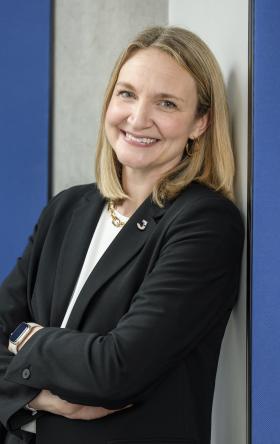A View on the Future of Remediation & Regeneration: A Q&A with Sharon Minchak
Embracing historical lessons and industry innovation in remediating and regenerating our communities

There is a foundational human element that must be considered in remediation and regeneration. The natural systems in the world – climate change, evolution of society and industry, and changing behaviors impact us all.
Responding to these impacts is what firms like Jacobs and society has been doing for generations. The reality though is that the work to achieve a cleaner, more resilient, sustainable and healthier world never stops. It evolves to become more sophisticated as our understanding of how contaminants impact people and as we integrate digital tools and AI into the next generation of solutions.
During the past few decades, the Environmental Business Journal (EBJ), Climate Change Business Journal (CCBJ) and Engineering News-Record (ENR) has recognized Jacobs for industry leadership in environmental restoration, remediation, policy innovation, data-driven engineering, and proprietary (and patent pending) site evaluation tools for hard to abate “forever chemicals” like per- and polyfluoroalkyl substances (PFAS). The main reason for this success? Harnessing an integrated, full-systems approach with the best cross-sector talent and pioneering technology in partnership with clients. Crucially, this goes beyond solving the immediate remediation challenge: it offers an opportunity to deliver social, economic and environmental value in our communities. It's about creating a new, sustainable legacy for the people and places impacted.
In this Q&A, we connect with Sharon Minchak, our global solutions director for remediation and regeneration, to discuss what she sees as a blueprint for long-term success in this sector.
What are the biggest challenges in the remediation and regeneration space and how do these things form the foundation of opportunity?
Things we as humans have done in the past have impacted our natural world and created consequences we didn’t understand or foresee at the time. We now need to mitigate those consequences, learn from our mistakes and move forward with a keener sense of the impact of our actions. After all, every action creates a reaction.
We need to combine the best learnings of the past with the potential of the future and be agile and flexible—ready to adapt technologies and approaches to different requirements and look outside our traditional environmental remediation skillsets to create new solutions. This kind of multi-faceted challenge isn’t for everyone. This is an industry that’s constantly changing and requires life-long learning that always seeks to harmonize the spirit of innovation with the voice of experience. That’s asking a lot - but we have a lot at stake. I see every day as a great opportunity to meet these complex challenges head-on and make the world a better place.
There has been a seismic shift in awareness on the impact of climate change and emerging contaminants on public health and wellbeing. How will these new areas, issues and trends shape the industry?
Right now, everyone is talking about PFAS. It is a good example of a topic that 10, 20, 30 years ago we didn't see as an issue. These are manmade substances that have a lot of important uses in industry. For instance, PFAS is in modern-day firefighting foam. It does a really good job addressing a real and acute risk. It’s only in the past ten years we've started to look closely in the U.S., and realized these compounds are impacting our environment and producing chronic concerns related to our health and ecosystems. And the same is happening around the globe. PFAS is the beginning but as we analyze more compounds, push detection limits lower and expand our understanding of subtle health impacts, we will see the emerging contaminant cycle repeat again and again as we learn the impact of past choices.
Recognition of how environmental issues are having an impact on our world and climate change awareness in general is creating a shift in our industry. Remediation projects are no longer just about cleaning up contamination but also finding ways to conserve energy, improve climate resilience, increase biodiversity and provide positive social outcomes for communities. We’re entering an exciting time where remediation projects can provide the canvas for creating many valuable outcomes in our communities.
How do you help clients think differently to respond to future challenges?
One of the ways we help clients respond differently is by guiding them to look through a programmatical lens, fund creatively and maximize their contracting structure to accelerate progress and depart from a traditional linear and stepwise process for clean-up activities. For instance, our five-year contract helping the U.S. Environmental Protection Agency (EPA) clean-up and restore 22 of the 25 remaining Great Lakes Areas of Concern by 2030 is an illustration of a more focused and flexible contracting mechanism built to address a specific need. Through this contract structure, we’re able to visualize and implement longer-time, integrated solutions that are sustainable and that the EPA can easily implement, creating bigger benefits for stakeholders. In a similar lens, we’re taking a whole systems approach in Australia working with government to develop an Investigation Framework for PFAS contamination liability across 37 airports to evaluate and prioritize human and ecological risk. We are now implementing this framework through detailed investigations and management plans at eight of the airports. Looking at areas of concern from a holistic perspective allows us to leverage innovation across the board, streamline and repeat best practices, and enhance vital aspects like stakeholder involvement through digital technologies rather than one-off site-by-site solutions.
Is there a project that you look back at that you're most proud of or most exemplifies the work Jacobs does?
We have a fantastic project with the U.S. Army Corps of Engineers – the New Bedford Harbor Superfund site in Massachusetts. It's ongoing now, and it’s been a work in progress for 20+ years. That may seem like a long time to work on a project, but it is a massive undertaking. The clean-up challenge is a result of everyone’s classic picture of old-fashioned industrial dumping of things like polychlorinated biphenyls (PCBs), metals and solvents into the harbor. Forty years ago, it was an environmentally decimated ecosystem. We’ve done a huge amount of dredging, excavation, capping, stabilization and revegetation to redevelop and regenerate that harbor. I recently visited the site and stood in awe at the birds swimming in the harbor and people boating — something I wouldn’t have imagined when we started the project.
And the benefits extend beyond environmental. This is now a commercial catalyst, spawning economic redevelopment in the old industrial buildings, attracting new businesses, adding desired housing and creating open spaces and a multi-use pedestrian trail.
This is why we do the work we do. It may take 20+ years to secure and deploy funding and execute remediation activities, but you can visibly see the changes we’ve made and how a once forgotten dirty harbor now offers vibrant community spaces, recreation facilities and a place to enjoy the great outdoors.
About the interviewee
Sharon Minchak serves as Jacobs’ Global Solutions Director for Remediation & Regeneration. She is a licensed Professional Geologist with a bachelor's in geosciences from The Pennsylvania State University and a master's in earth and planetary Sciences from the University of New Mexico. Sharon has 30+ years of global experience serving a diverse set of government and private sector clients, working across all aspects of the Environmental market from planning and permitting, to regulatory compliance and sustainability, to investigation, remediation and regeneration.
Considered a leading subject matter expert in the Remediation & Regeneration space, Sharon has specific experience with emerging contaminant assessment, characterization, treatment and research across multiple sectors, including water, transportation, private and federal portfolios, including Superfund sites. Outside of work, Sharon loves cooking, gardening, hiking, camping and generally being outside. She’s a geologist by training and professionally, but also really enjoys visiting beautiful places with notable geologic features and great rocks!
Future Foundations.
Co-creating the world to come

From developing climate resilience and transitioning to a low-carbon future, to modernizing and transforming infrastructure, governments and businesses face critical challenges. How they respond will define our future.
As our clients navigate these challenges, we help them think differently – working together to pioneer tomorrow's infrastructure solutions and build the foundations for a prosperous, secure future.














































